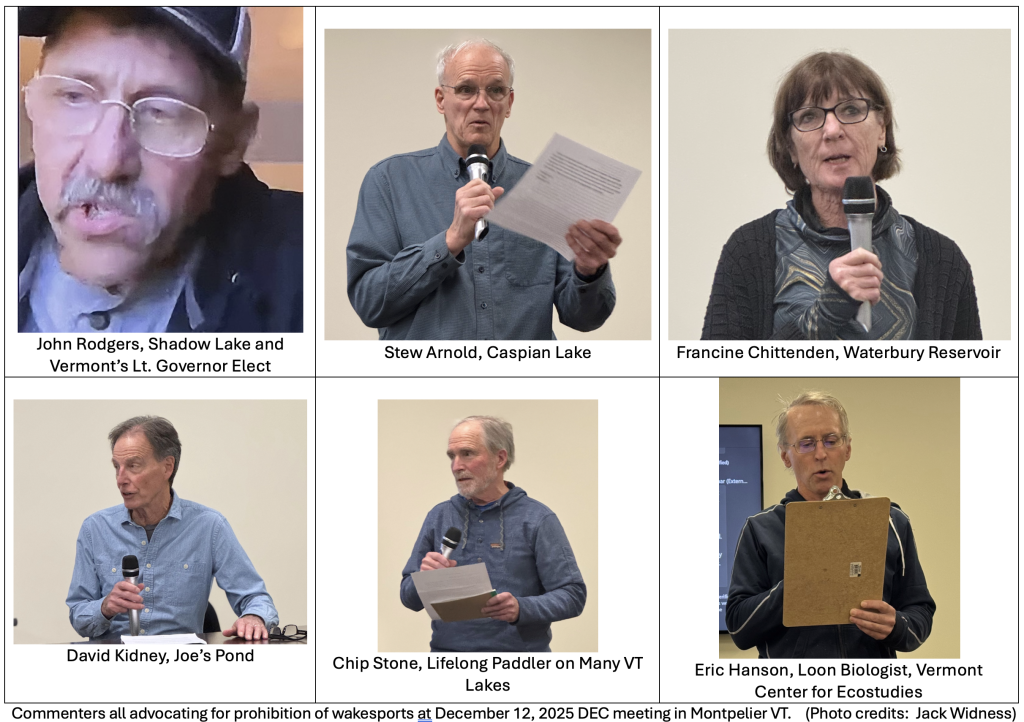In the words of Dani Sharpe — one of our most passionate founders, supporters and protectors of Vermont lakes: “What a year we have had! It started with our battle in Montpelier to get the first comprehensive statewide wakesports and is ending with a push for much-needed stronger regulation on the 10 lakes” that submitted individual petitions to the ANR for additional protection from the ravages of wakesports and wake boats. “It has been a year we won’t forget. It’s something that perhaps many would say couldn’t be done. It’s been a group effort, with support from many of us.”
The dedicated, tireless effort by so many during the pre-rulemaking petition process for these new individual lake petitions over the past several months has been most impressive. In their compelling comments at the December 10 and 12 public hearings, the petitioning lakes provided strong arguments and evidence for the ANR and DEC to support the requests for prohibiting wakesports (and in several cases, wake boats) on their waters (see photos). All nine petitions (covering ten lakes) presented during the two hearings were well thought out and supported.

Approximately 125 speakers addressed the ANR and DEC during nearly eight hours of public testimony across the two meetings. Over 90% of those testifying supported the stronger rules proposed in the petitions; the great majority shared their concerns about the safety of others on the water, an issue not addressed by the DEC in last year’s initial rulemaking process. They vividly described near-miss experiences with wake boats in wake sports mode and how wake boats are altering everyone else’s ability to enjoy more passive recreation. They spoke about how they – and others they know – leave the water when wake boats are launched by retreating to the beach and elsewhere. The petitioners’ comments were rooted in fact, effectively presented, and clearly heartfelt.
There were also many comments focused on wake boats’ unique contribution to the threat of spreading new aquatic invasive species and how their transport of ballast water between lakes is a challenging problem to solve and that conflicts with Vermont statute, i.e., the Vermont Aquatic Nuisance Control Program (10 V.S.A. § 1454(a)).
A handful of wake sports enthusiasts opposed the petitions, pointing to a recent wake boat incident report issued by the DEC. Several speakers repeatedly and effectively challenged the validity of this report; law enforcement authorities are aware that incident reports underestimate the actual number of issues. It is acknowledged that the effort required to report and the lack of enforcement discourages people from filing complaints. Other testimony pointed out simply that the presence of wake boats causes normal users to leave the lake or refrain from venturing out on the water altogether – resulting in further underreporting of the full impact wake boats have on lake recreation and incident reporting.
New research was published during the comment period documenting the damage to lake bottoms at depths as great as 26 feet – at least 6 feet deeper than established by previous studies and adopted by ANR in its Wakesport Zones criteria. This new research, recently brought to the attention of the ANR, provides further rationale for the ANR to more forcefully apply the well-accepted Precautionary Principle and extend the depth requirement beyond 20 feet.
The DEC’s next step in the individual lake petition process is to review the petitions’ comments and the technical merits.
- The DEC Commissioner will decide to either deny a petition or to initiate rulemaking (anticipated in early 2025).
- If rulemaking proceeds, there will be additional public comments required on the proposed rule.
- New rules, if any, may be adopted in the spring, prior to the summer boating and camping season… but the DEC has indicated there are “many opportunities for bumps along the way.”
No one can predict if ANR will move any of the individual petitions into the final rulemaking process. We will have to wait and see how the ANR meets its prior commitment to address safety concerns and how it chooses to incorporate new research as it becomes available.
Links to videos of the Dec 10 and 12 public hearings can be found at https://dec.vermont.gov/watershed/lakes-ponds/lakes-and-ponds-rulemaking.
…………
The last four years have been difficult. We never could have predicted the twists and turns along the way. Much has been accomplished, but more work still lies ahead. With your help, we will continue to work to achieve our shared goals – protection of “normal uses” and the safety of users on our lakes and ponds, protecting our water quality by preventing the spread of aquatic invasive species, and the integrity of our lake bottoms.
It is with gratitude that we wish you a Happy and Heathy New Year. Onward.
email: responsiblewakesvt@gmail.com website: responsiblewakes.org
“Never doubt that a small group of thoughtful, committed people can change the world. Indeed, it is the only thing that ever has.” Margaret Mead
